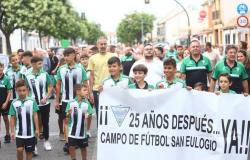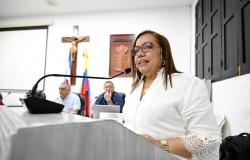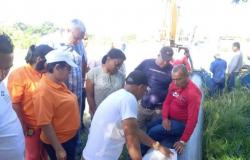«The people of Cordoba ignore that Cordovaand to a lesser extent Jaén, are the epicenter of the material and immaterial legacy through the foundations that the Carmelites left, with the two most important saints, who are Santa Teresa de Jesús and San Juan … from the cross». The Carmelite father and historian said it this Tuesday Oscar Aparicio in a day to publicize the importance of the province in the order, at the Faculty of Law of the University From Cordoba.
‘The heritage and tourism legacy of Santa Teresa de Jesús and San Juan de la Cruz in Córdoba and the province’ was the title of the initiative, in which Óscar Aparicio, who is finalizing a book on the impact of the order, reviewed the step of Santa Teresa through Córdoba, the convents and Carmelite facades in Córdoba and the experiences of the doctor of the Church and writer.
The footprint of San Juan de la Cruz was also great, who was provincial vicar in Córdoba and founded the convent of San Roque, of which today the church of the same name and the current residence that bears the name of the author of the ‘spiritual song‘.
There it is, he remembered, the cell where he slept and where he was saved from the fall of a wall. She then said that she had saved him by “the Lady of the white cape”, alluding to the Virgin of Carmen. This cell, she said, “can be a place for tourist visits of quality who appreciate culture and heritage.
That community ended up moving to the current convent of San Cayetano, which could also be a place to visit due to the beauty of its ornamentation. baroqueits altarpiece and the image of the Virgin of Carmen that presides over it.
He also participated in the day Miguel Arroyotour guide of the Mosque-Cathedral of Córdoba, who lamented the “lack of information in different parts of the province. “The signage was very scarce and sometimes non-existent,” he said, showing photographs.
Dispersion
The legacy in Espejo stood out, Aguilar de la Frontera, Bujalance, Lucena, Montoro or Hornachuelos, but the conclusions were that “the resources are dispersed, not valued in terms of tourism and not very visible.” That is why the participants advised creating a network to “show the traces.”
As explained José Manuel Mármolformer manager of the Provincial Tourism Board of Córdoba, a route can also be “a way for the conservation of this heritage so precious and unknown to the world.” public».
The role of the public administration can be fundamental then. The event is a prelude to the International Heritage Tourism Management Congress (Cigestur) with the collaboration of several entities.
#Colombia





